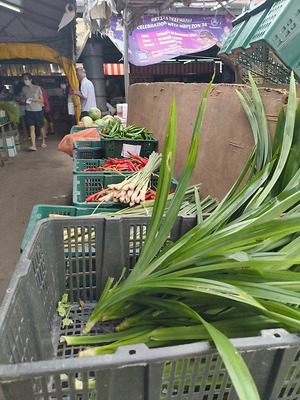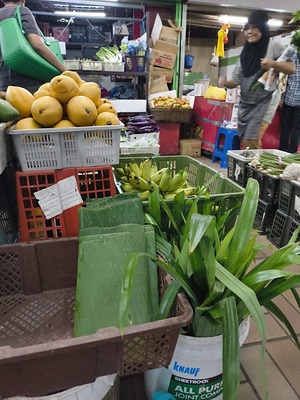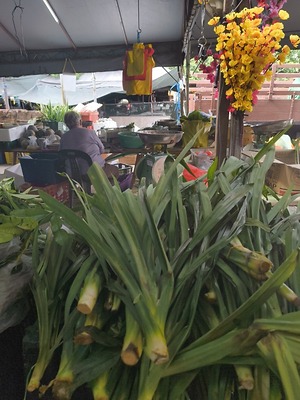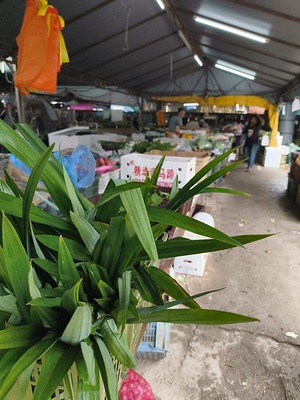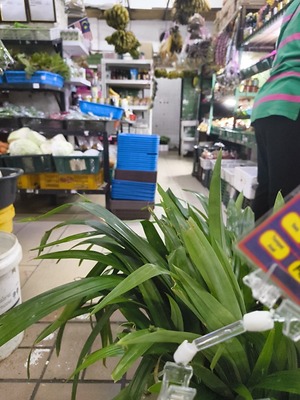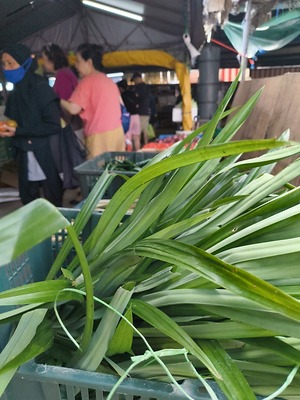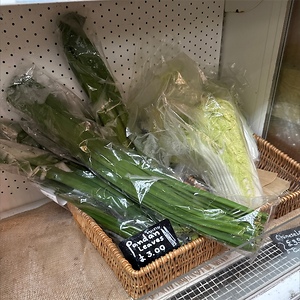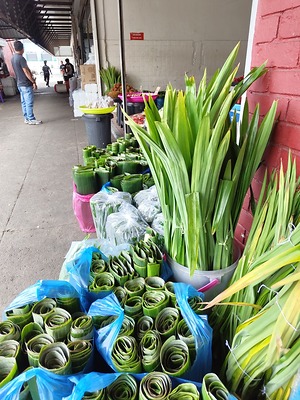

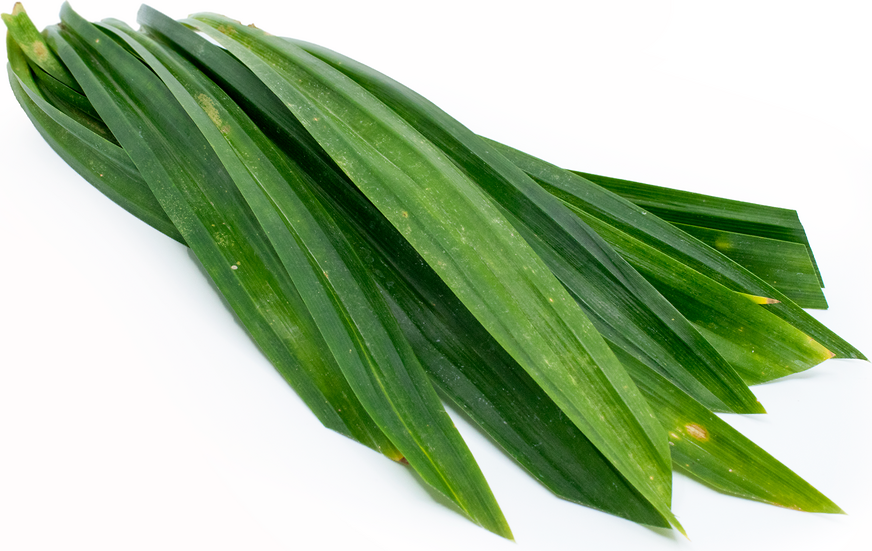
Pandan Leaves
Estimated Inventory, lb : 3.00
This item was last sold on : 07/19/25
Description/Taste
Pandan leaves have an elongated, narrow appearance, ranging from 2 to 9 centimeters in diameter and 25 to 220 centimeters in length, depending on growing conditions. The leaves typically appear in short or large growth forms, varying with how they are cultivated. Shorter growth leaves are more oblong and have a thin and pliable shape, while larger growth leaves are dark green with a thicker, blade-like shape. The leaves grow in an upright, spiral formation with straight edges, tapering to a defined, pointed tip. The leaf’s surface is striated, lightly textured, and semi-smooth, sometimes featuring small spines along the edges or under the mid-rib. The leaves have a fibrous nature and are not eaten. They are instead added to dishes to infuse flavor, coloring, and aroma. Pandan leaves have a floral, herbal, sweet, and grassy scent without earthiness. The leaves also have a bright essence, often compared to emitting a vanilla-like nuance. Pandan leaves are infused into culinary dishes, leaving a sweet, grassy, and floral taste with notes of roses, almonds, and vanilla.
Seasons/Availability
Pandan leaves are available year-round.
Current Facts
Pandan leaves, botanically classified as Pandanus amaryllifolius, are the fragrant greens of a tropical to subtropical plant belonging to the Pandanaceae family. The species is one of the only types within the Pandanus genus with aromatic leaves and appears in a shrub or small tree form, reaching 1 to 4.5 meters in height. The plant's overall shape depends on growing conditions and the harvest of the leaves. Pandan plants will remain smaller and more compact if the greens are continuously picked. Pandan leaves are revered and well-known throughout Southeast Asia for their fragrance, flavor, and ability to impart coloring into culinary dishes and beverages. The leaves can be gathered six months after planting and are a species primarily found in domesticated or home gardens. Pandan leaves are known by many regional names, including Daun Pandan, Pandan Wangi, Pandan Musang, and Pandan Rampeh in Indonesia and Malaysia, Pandan Rampai in Sri Lanka, Annapurna and Ramba in India, Toei, Toey-Hom, Bai Toey, and Panae-wo-gning in Thailand, Cay com nep, Dua thom, and La dua in Vietnam, and Ban Yan Le in China and Taiwan. In English, the species is known as Screwpine, Umbrella Tree, Fragrant Pandan, and Fragrant Screwpine. Pandan leaves are a common household ingredient throughout Southeast Asia and parts of Southern and East Asia. Outside of Asia, the species is increasing in notoriety but is still relatively rare. Pandan leaves are versatile and utilized in a wide array of sweet and savory preparations.
Nutritional Value
Pandan leaves are noted for their anti-inflammatory and antioxidant properties, which protect overall bodily health. The leaves are topically applied to wounds, skin irritations, and burns to provide reprieve and a cooling feel, while extracts from the greens are sometimes used in natural medicines for internal aches and pains. Pandan leaves also provide fiber to aid digestion and help reduce bloating. The leaves contain vitamins A, C, and E to strengthen the immune system, guard the cells against free radical damage, and maintain healthy organs. They are also believed to provide calcium, iron, potassium, and magnesium to balance fluid levels within the body, support bone and teeth health, and maintain healthy nerve functions. In Southeast Asia, Pandan leaves have historically been infused into shampoos, scalp treatments, and baths. The leaves are also used as natural air fresheners and can be frequently seen tied in taxi cabs, chopped on plates in homes, or placed along the edges of floors to repel insects.
Applications
Pandan leaves are widely utilized for their coloring, flavor, and fragrance in sweet and savory dishes. It is important to note that the leaves are not eaten but are added to recipes to extract their essence, aroma, and liquid. Pandan leaves are famously infused into rice dishes throughout Asia. The leaves impart a smell reminiscent of premium rice types like Basmati, Kaorimai, and Jasmine, and are used to elevate common steamed rice dishes. Some communities also weave baskets from fresh Pandan leaves and steam rice. In addition to steamed rice, Pandan leaves are incorporated into sticky rice dishes or tied into knots and simmered in soups, curries, stews, and sauces. Pandan leaves can be tossed into any dish to add a unique flavor. Pandan leaves are notably used to wrap chicken and fish, and are grilled in Thailand. Pandan leaves are also pan-fried with curry leaves in India and Sri Lanka to create a rich, base flavoring for curries, potato dishes, and rice. Beyond savory dishes, Pandan leaves are well-known for their use in desserts. Across Southeast Asia, Pandan leaves are nicknamed the “Vanilla of the East” and are infused into cakes, custards, jams, jellies, and ice cream. The juice extracted from the leaves has a natural, bright green coloring, enhancing desserts with this hue. In Singapore and Malaysia, kaya jam is a traditional Pandan-flavored coconut egg jam, often slathered on sandwiches or layered between crackers. The leaves are also used in Singapore to flavor chendol, a Pandan-flavored jelly noodle chilled with coconut milk and palm sugar syrup. The leaves flavor sweet rice balls, pancakes, and sponge cakes in Indonesia. While Pandan leaves are often associated with culinary uses, the greens are also infused into beverages like tea, fruit drinks, juices, and milk tea. Taiwanese indigenous communities, such as the Taroko, enjoy Pandan tea for its refreshing, bright nature, and other ingredients like coconut milk or lemon are sometimes added for increased depth of flavor. Pandan leaves pair well with turmeric, lemongrass, vanilla, brown sugar, and coconut. The leaves should be stored unwashed, wrapped in a damp paper towel, and sealed in a plastic bag in the refrigerator, where they will keep for a few days to one week. Pandan leaves can also be frozen for several months or dried for extended use.
Ethnic/Cultural Info
Pandan leaves often symbolize purity and freshness and are used as a fragrance to welcome blessings in Southeast Asia. The aromatic leaves are cut or torn and incorporated into religious ceremonies in Bali, Indonesia. They are also woven into baskets, mats, decorations, and other goods as physical temple offerings, especially in Hindu practices. It is customary for a daily offering to be given by Balinese Hindus, known as canang sari. These offerings are nestled into hand-woven baskets, typically from palm leaves, but Pandan leaves are sometimes used as an alternative for their aroma. Pandan leaves are also placed as decorations on gifts and offerings for their pleasing smell, a scent to appease the gods. While less common in the present day, some sources claim that Pandan leaves were used beyond religious purposes in Southeast Asia and were hand-woven into flower-like shapes. These blooms were gifted in bouquets to loved ones as a creative display of affection.
Geography/History
Pandan leaves are believed to be native to Southeast Asia and were domesticated in ancient times. Much of the history of the species is unknown, as true wild forms have not been discovered. Scientists believe that a possible center of origin for early wild types may be near the Maluku Islands in Indonesia, but the plant was quickly spread across Asia through migrating peoples, expanding and naturalizing the species. Pandan has become established throughout Southern, Southeastern, and East Asia and was first recorded in English through Scottish botanist William Roxburgh in 1832. The species has also been introduced to tropical and subtropical climates worldwide, but has remained relatively rare, being grown as a specialty home garden plant. Today, Pandan leaves thrive in warm, humid regions, especially in coastal areas, damp forests, swamps, and nearby rivers. The species can grow in partial shade to full sun and is considered a popular ornamental and culinary plant in Asia. Pandan leaves are sold fresh in markets mainly in Asia and are offered in limited quantities, dried and frozen worldwide. Other regions, like Central America, South America, and Australia, may also sell fresh Pandan leaves seasonally through select growers, but the availability is inconsistent.
Featured Restaurants
Restaurants currently purchasing this product as an ingredient for their menu.
| Raised By Wolves | San Diego CA | 916-207-1076 |
| Huntress (Bar) | San Diego CA | 619-955-5750 |
| Part Time Lover | San Diego CA | 619-588-2411 |
| University Club | San Diego CA | 619-234-5200 |
| Happy Medium SD (bar) | San Diego CA | 509-869-2279 |
| Animae | San Diego CA | 619-925-7908 |
| Waverly (Bar) | Cardiff CA | 619-244-0416 |
| Relic Bageri LLC | San Diego CA | 619-335-6328 |
| Under Belly-Uptown | San Diego CA | 619-269-4626 |
| Monarch (Bar) | Del Mar CA | 619-308-6500 |
| Fort Oak | San Diego CA | 619-795-6901 |
| Understory | San Diego CA | 516-507-0101 |
| Juniper & Ivy | San Diego CA | 858-481-3666 |
| The Taco Stand | San Diego CA | 619-549-9919 |
| Under Belly-Little Italy Bar | San Diego CA | 619-269-4626 |
| Saint Mark Golf and Resort, LLC (Bar) | San Marcos CA | 508-320-6644 |
| Fishery - Bar | San Diego CA | 858-272-9985 |
| Rancho Valencia | Del Mar CA | 858-756-1123 |
| C 2 C | San Diego CA | 619-972-9345 |
| Madi | San Diego CA | 320-491-1217 |
| Pendry SD (5th & Rose) | San Diego CA | 619-738-7000 |
| San Diego Yacht Club | San Diego CA | 619-758-6334 |
| Under Belly-Uptown (Bar) | San Diego CA | 619-269-4626 |
Recipe Ideas
Recipes that include Pandan Leaves. One



